The Last days of Japanese Steam Engines
Part 1After a one year period
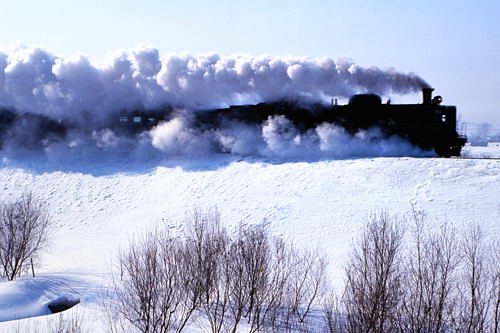
|
|
One of my favorite photos, seen here, during Hokkaidos most frigid season, a C57 spews steam above while whirling powder snow beneath. The C57 during her last days of service in Muroran line in Mar 1975. |
|
Regular service of the Japanese government railway for running steam locomotives ended on March 2nd 1976 in Hokkaido.
From that time on, Japanese steam locomotives could only be seen in museums, parks and special events and as such,
can be easily viewed at the present time.
Japanese railway history started in 1872.... it was also the beginning of steam's history too. Since then, their numbers have reached a maximum of 5958 in 1946. But thereafter, thinning steam numbers declined to 1500 from electrification and dieseling in 1971. Five years later they were gone completely. When considering Japan as a whole, the first area for the abolition of steam was Shikoku in the South West part of Japan during April of 1970. And next the Kanto area (Tokyo) was in October 1970, Kinki (Osaka, Kyoto area) September 1973, Chubu (Nagoya, Nagano area) April 1974, Tohoku (Northern part of Honshu main Island) November 1974, Chugoku (most Western part of Honshu main land, Yamaguchi area) December 1974, Kyushu (Most Western Island) January 1975 and finally followed the Northern Island of Hokkaido in March 1976. |
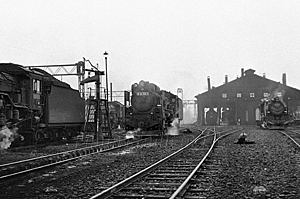
Japanese steam engines and their prime time depot. Takikawa depot. |
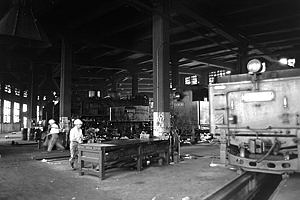
Interior scene of roundhouse Aizu-Wakamatsu depot, during 1970 |
|
All of Kyushu's steam locomotives were closed from 1975,
Japanese Rail-Fans watched the moves of activity to the last extremity of Hokkaido's steam engines.
Then the question arose as to when the Japanese governments use for business purposes would end ?
On the 25th of November during 1975, the last 60 of Hokkaido's steam engines were almost replaced with diesel locomotives. Therefore, Rail-Fans understood "The Last Day" very clearly. As of November 25, steams last runs were on ; part of Nemuro Line, Muroran Line, Yubari Line, Utashinai Line and Horonai Line. (Utashinai and Horonai Line where closed in 1987 and 1988). During 1975, there was a frequency of strikes with JNR labor. These severe disputes caused frequent cancellation of many JNR trains with delays as well. As a result, the date of dieselization has been shifted many times. And also "The Last Day" was in a fluid situation. |
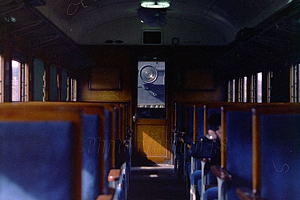
Photo from Uetsu line's regular servic steam train D51_871. |
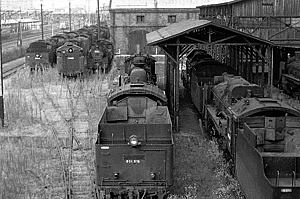
Steam engines awaiting dismantlement. Such scenes were often seen during the 70's Nagano JNR works, C11 96 D51 C58s ... |
|
JNR Hokkaido Directorate announced during the 26th of November 1975,
that "The last steam passenger train will run on the 8th of December with class D51,
and the last freight train will run on the 26th of December."
But "D51 is a freight model, it was improper for a last passenger train run ..... ",
which raised a chorus from rail fans.
And the Tokyo Transportation Museum (now Saitama Railway Museum) had a plan for last engine preservation, it was hoped that the preserved engine class would be passenger model C57. At that point in time, the last five C57s (No.38, 44, 57, 135 and 144) were deployed in Iwamizawa depot, but they already ceased service during the 25th of November. Therefore, the final passenger train run by C57 was a non-standard situation. Additionally there was concern in regard to the Final Special Train run due to strike disruption possibilities. Late in the day, JNR Hokkaido proposed a new schedule. The new schedule announced that in place of the 5th of December the " Last steam passenger train would run on the 14th of December with train No.225 on the Muroran line..... Muroran to Iwamizawa with a class C57, No.135." |
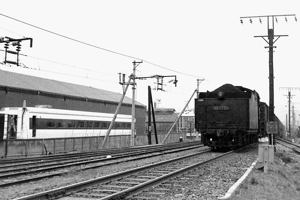
Echujima line's D51_770 was running alongside a newly manufactured car of the Shinkansen in Tokyo during Feb 1969 |
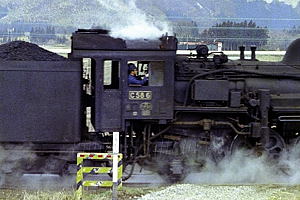
East-Rikuu line C58_6 |

Part 2
Final Passenger Steam Train
